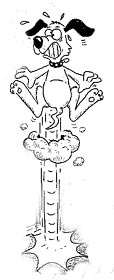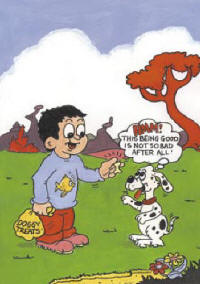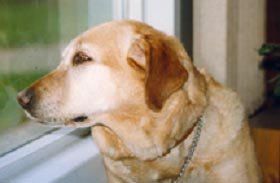Why
is my dog afraid of people and/or
other animals?
There
are many reasons that dogs can
develop a fear of people or
the other animals. Firstly,
there may have been limited
or minimal exposure to people
and/or other animals when the
dog was young. Socialization
is an important aspect of raising
a puppy. Without adequate, constant
and positive interactions with
people and other animals dogs
may develop fears. In fact,
fears may be very specific so
that a dog that has been adequately
socialized to a particular "type"
of person such as adult males,
may show fear toward children,
men, women, teenagers, or people
of other races. Similarly, dogs
that are well socialized to
other dogs may show fear toward
other animals. Secondly, dogs
are impressionable and through
the effect of "one trial
learning" may take one
experience that was intense
or traumatic and generalize
to many similar situations.
This can occur, for example,
with a bad experience with a
small child which then makes
the dog fearful of all small
children, or a fight and subsequent
injury from other dogs. Sometimes
a number of unpleasant events
"paired" or associated
with a person or animal can
lead to increasing fear. For
example, if a pet is punished
(especially with a painful device
such as a pinch or shock collar)
when it is exposed to a person
or other animal, it may begin
to pair the stimulus (the person
or other animal) with the unpleasant
consequence (punishment). This
is especially true with the
use of a painful device such
as a pinch or shock collar.
Can
I prevent fears from developing?
As
mentioned above, socialization
is the cornerstone to raising
a dog that is comfortable with
people. Early, frequent and
pleasant encounters with people
of all ages and types can help
prevent fears later. This exposure
should begin before 3 months
of age and continue throughout
the first year. In addition,
the dog should be exposed to
as many different environments,
sights and sounds as possible
so that they become accustomed
early, before fears emerge.
What
signs might my dog show when
she is afraid?
When
frightened, a dog may cower,
look away, tuck its tail and
perhaps tremble or pant. At
other times the signs may be
subtler. A dog may only duck
its head and look away, and
tolerate petting at first, but
then snap. It is important to
watch your dog for signs of
uneasiness such as backing up,
hiding behind you and licking
of the lips. Naturally growling,
or snarling would indicate aggression,
but may also indicate fear.
(see our handout on ‘Fears,
Phobias and Anxieties').
What
information do I need to identify
and treat my fearful pet?
Usually
a behavioral consultation is
needed for dogs that are showing
extreme fears and/or aggression.
If the fears are mild, then
owner intervention may help
to improve the problem or at
the very least prevent them
from progressing. First, it
is important to identify what
is the fearful stimulus. This
is not always easy and needs
to be very exact. What persons
or animals is the dog afraid
of and where does the fearful
behavior occur? Often there
are certain situations, people,
and places, that provoke the
behavior more than others.
For
treatment to be most successful,
it is important to be able to
place the fearful stimuli along
a gradient from low to high.
In other words, you want to
identify those situations, people,
places and animals that are
likely to cause minimal fear
as well as those situations,
people, places and animals that
are most likely to cause the
fearful behaviors.
Next,
you need to also examine what
factors may be reinforcing the
behavior. Some owners actually
reward the manifestations of
fear such as trembling or growling
by reassuring their pets with
vocal intonations or body contact.
Aggressive displays are a successful
way of getting the fearful stimulus
to leave and thus also reinforce
the behaviors. Any ongoing interactions
that are fear provoking need
to be identified. This could
be teasing behaviors, anxiety
or aggression on the part of
the stimulus (people or other
animal), anxiety on the part
of the owner/handler, painful
interactions including the use
of punishment (discussed previously),
or overwhelming stimuli.
 After
I have identified the stimuli,
what do I do next? After
I have identified the stimuli,
what do I do next?
Before
a behavior modification program
can begin, you need to be able
to control and communicate with
your dog. This will require
some training. Often in addition,
a head collar will be needed.
Head collars allow control of
the dog's head and neck
to ensure that the dog responds
to the given command (sit, quiet,
and heel). To make the dog feel
more secure by knowing who is
the "leader", orient
the dog away from the stimulus,
and prevent the dog from either
causing injury or escaping.
Next,
teach your dog that when it
sits and stays it will receive
a delicious food reward. The
goal of this training is to
allow the dog to assume a relaxed
and happy body posture and facial
expression on command. Once
this is established, then food
rewards are phased out. See
our handout on ‘Puppy
– Training Basics'.
Lastly,
begin counter-conditioning and
desensitization to acclimate
the dog to the stimuli that
usually cause the fearful response.
This needs to be done slowly
and cannot begin until your
dog can reliably relax on command
in the absence of the stimulus.
This is where the gradient that
you established earlier becomes
helpful and can be the most
difficult part of the program
since it is generally necessary
to set up situations where you
can control the dog and the
stimulus. Therefore, inviting
people to the house, or having
some neighborhood children ride
their bikes back and forth along
the street, may be necessary
so that you can insure that
the stimuli are predictable
and well controlled (see the
example of delivery people below).
Start by exposing the dog to
very low levels of the stimulus,
in fact ones that do not evoke
fear. The dog is then rewarded
for sitting quietly and calmly.
Gradually, if the dog exhibits
no fear, the stimulus intensity
is increased (see our handout
‘Behavior Modification
- desensitization, counter-conditioning,
differential reinforcement and
flooding'). It is extremely
important that this is done
slowly. The goal is to associate
a calm, positive outcome with
the once fearful stimulus by
only rewarding the desirable
response. If the dog begins
to show fear during training,
it is progressing too fast and
could be making the problem
worse. Always set up the dog
to succeed. The use of the leash
and head collar can greatly
improve the chances of success
and because of the additional
control, will often help the
owner to succeed in getting
the dogs attention and calming
it down; faster than with commands
and rewards alone.
But
my dog may still encounter the
fearful stimulus when we are
not in a training exercise.
What should I do then?
Each
time the dog experiences the
fearful stimulus and reacts
with fear, the behavior is further
aggravated. If possible, it
is helpful to try and avoid
the fear-producing stimulus.
This may mean confining the
dog when children visit, or
the house is full of strangers.
Alternately, walks may need
to be curtailed or scheduled
at times when encounters with
other people and animals can
be minimized.
If
you do find yourself in a situation
where the dog is responding
fearfully, do not raise your
voice or punish your dog as
this will further increase his
or her anxiety. If your dog
is wearing a head halter it
may be possible to reorient
the dog so that you can get
eye contact and to pull up and
settle the dog so that the dog
learns to ignore or accept the
approaching stimulus. Another
option is to use a "happy"
tone of voice and walk just
far enough away that the dog
can be successfully distracted
and settled.
How
might these techniques be used
in a training situation?
Take
the example of fear toward a
delivery person. Begin by training
the dog to sit and stay quietly
throughout the house and then
by the window and doorway in
the absence of anyone approaching.
Use only reward based training
techniques along with perhaps
a head halter to ensure success.
Use clicker training or a favored
reward such as a toy or treat
to mark and reward acceptable
responses. As the dog begins
to anticipate that a favored
reward is imminent the dog's
attitude or "mood"
should be positive rather than
anxious and aggressive. The
relaxed sit stay and  expectation
of rewards are incompatible
with the behavior you wish to
change, in this case lunging
at the window at a delivery
person. Once the dog learns
to quickly settle and anticipate
food at each location on command,
training with varying forms
of the stimulus can begin. It
may take days or weeks for the
dog to learn how to perform
this task reliably on command.
During that time phase out food
rewards so that the dog does
the task equally well with or
without food. expectation
of rewards are incompatible
with the behavior you wish to
change, in this case lunging
at the window at a delivery
person. Once the dog learns
to quickly settle and anticipate
food at each location on command,
training with varying forms
of the stimulus can begin. It
may take days or weeks for the
dog to learn how to perform
this task reliably on command.
During that time phase out food
rewards so that the dog does
the task equally well with or
without food.
Next,
train the pet to perform the
desired behavior in the presence
of a variety of stimuli that
are similar to the actual problem
stimulus (e.g. strangers walking
across the property). Using
desensitization, the stimulus
is presented at a muted or low
enough level so that the dog
can be kept settled and shows
no fear or anxiety. Training
could begin by having a family
member stand by or walk by the
window, and then progress to
a stranger at the edge of the
property. The owner then practices
the training to ensure that
a calm settle response is achieved
and rewarded. Again favored
rewards, toys or clicker training
should be used for each new
step in the program. Again a
head halter can be used to ensure
a quick and successful response.
Repeat this many times so that
the dog does it reliably and
gradually have the person move
closer to the window until the
person can walk by while the
dog relaxes or plays and gets
its reward. Rewards are faded
out once each new level is achieved
and reintroduced for each new
step along the way. The dog
is learning the new acceptable
response that earns the reward
(response substitution) and
is acquiring a positive association
with the stimulus. Proceed slowly,
so that the dog learns to perform
the desired behavior over and
over before being challenged
with the real thing,
Finally,
progress to stimuli that more
closely resemble the real life
situation. Perhaps have the
dog sit by the window when a
friend or family member dressed
as a delivery person walks by
the property and finally progress
to sessions with delivery people.
Some dogs may progress faster
if the training is done outside
with stimuli across the street
or walking across the property.
This client
information sheet is based on
material written by Debra Horwitz,
DVM, DACVB and
Gary Landsberg, DVM, DACVB.
© Copyright 2002 Lifelearn
Inc. Used with permission under
license. March 11, 2004.
|